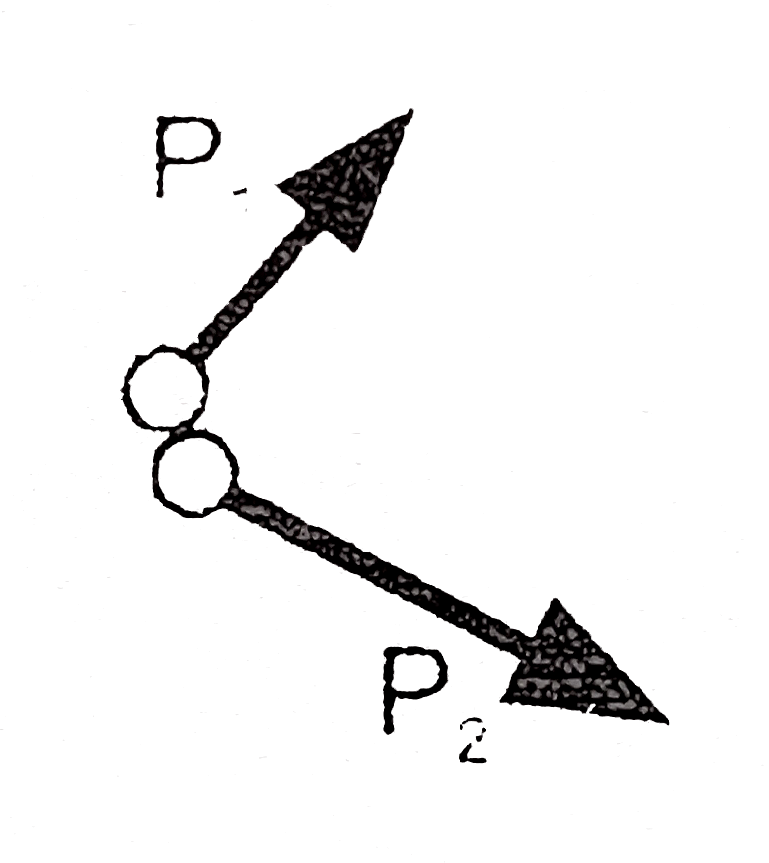Two identical non-relativitic partcles A and B move at right angles to each othre, processing de Broglie wavelengths λ1 and λ2, respectively. The de Broglie wavelength of each particle in their centre of mass frame of reference is
The correct Answer is:λ=2λ1λ2√λ21+λ22
Let ¯p1 and ¯p2 be the momenta of the two paritlces.
The velocity of the centre of mass

Hence, momentum of paritcles 1 in c.m. frame
→p1=m(→v1−→vcm)
=m→v1=m→p1+→p22m
=¯p1+¯p22
|→p1|=12√P21+P22−2P1P2cos90∘
hλ=12√h2λ21+λ22
Topper's Solved these Questions
- BOOK - RESONANCECHAPTER - ATOMIC PHYSICSEXERCISE - Exercise ( Part II : Only one one correct type)37videos
ATOMIC PHYSICS
- BOOK - RESONANCECHAPTER - ATOMIC PHYSICSEXERCISE - Exercise (2) Only one option correct type30videos
ATOMIC PHYSICS
- BOOK - RESONANCECHAPTER - ATOMIC PHYSICSEXERCISE - Solved miscellaneous problems14videos
ATOMIC PHYSICS
- BOOK - RESONANCECHAPTER - ALTERNATING CURRENTEXERCISE - HIGH LEVEL PROBLEMS11videos
ALTERNATING CURRENT
- BOOK - RESONANCECHAPTER - CAPACITANCEEXERCISE - High Level Problems16videos
CAPACITANCE
Similar Questions
Two identical non-re,aticivistic particles move at right angle to each other. Possesing de Broglie wavelength λ1 and λ2 Find the Broglie wavelength of each particle in the frame of their centre of inertia.
View SolutionTwo particles move at right angle to each other.Their de Broglie wavelengths are lambda_(1) and lambda_(2) respectively.The particles suffer perfectly inelastic collision.The de Broglie wavelength lambda of the final particle is given by :
View Solution
Knowledge Check
- Question 1 - Select One
The de-Broglie wavelength λ
Ais proportional to massBis proportional to impulseCInversely proportional to impulseDdoes not depend on impulse - Question 2 - Select One
Two electrons are moving with non-relativistic speeds perpendicular to each other. If corresponding de Broglie wavelengths are λ1 and λ2 , their de Broglie wavelength in the frame of reference attached to their centre of mass is:
AλCM=λ1=λ2B1λ1=1λ1+1λ2CλCM=2λ1λ2√λ21+λ22DλCM=(λ1+λ22) - Question 3 - Select One
Two identical non-re,aticivistic particles move at right angle to each other. Possesing de Broglie wavelength λ1 and λ2 Find the Broglie wavelength of each particle in the frame of their centre of inertia.
AλCM=(λ1+λ22)BλCM=2λ1λ2√λ21+λ22CλCM=λ1=λ2D1λCM=1λ1+1λ2
The de - Broglie wavelength associated with the particle of mass m moving with velocity v is
View SolutionThe ratio of de broglie wavelength of a proton and an alpha particle moving with the same velocity is
View SolutionA proton accelerated through a potential V has de-Broglie wavelength λ. Then, the de-Broglie wavelengthof an alpha-particle, when accelerated through the same potential V is
View SolutionThe de-Broglie wavelength of a particle of mass 6.63 g moving with a velocity of 100ms−1 is:
View SolutionTwo particles of de-broglie wavelength λx and λy are moving in opposite direction. Find debroglie wavelength after perfectly inelastic collision:
View Solution

